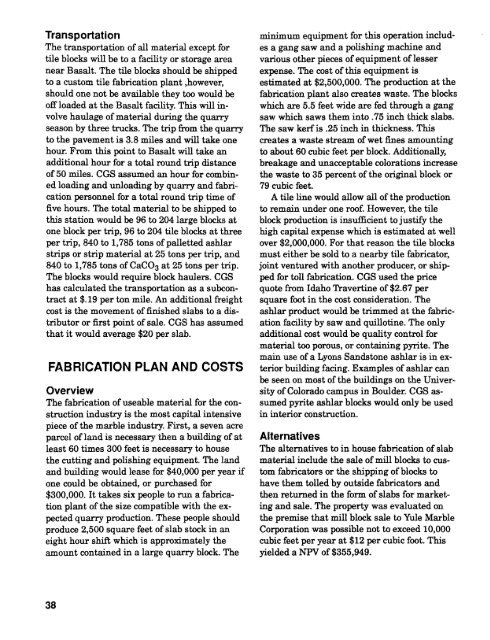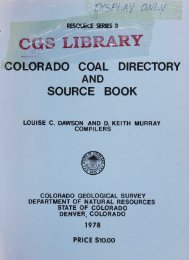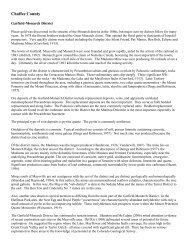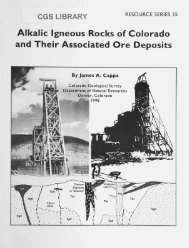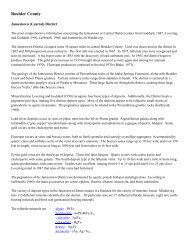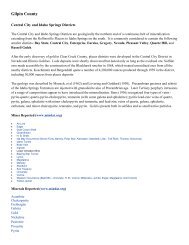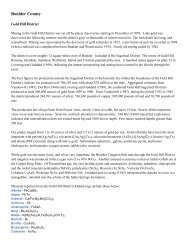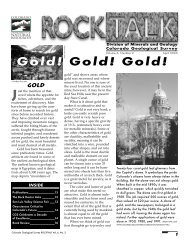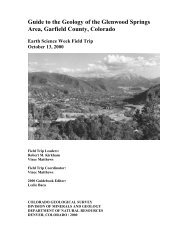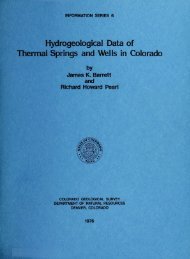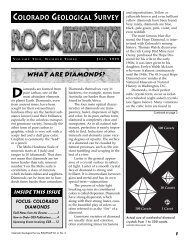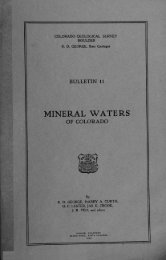Marble - Colorado Geological Survey
Marble - Colorado Geological Survey
Marble - Colorado Geological Survey
Create successful ePaper yourself
Turn your PDF publications into a flip-book with our unique Google optimized e-Paper software.
Transportation<br />
The transportation of all material except for<br />
tile blocks will be to a facility or storage area<br />
near Basalt. The tile blocks should be shipped<br />
to a custom tile fabrication plant .however,<br />
should one not be available they too would be<br />
offloaded at the Basalt facility. This will involve<br />
haulage of material during the quarry<br />
season by three trucks. The trip from the quarry<br />
to the pavement is 3.8 miles and will take one<br />
hour. From this point to Basalt will take an<br />
additional hour for a total round trip distance<br />
of 50 miles. CGS assumed an hour for combined<br />
loading and unloading by quarry and fabrication<br />
personnel for a total round trip time of<br />
five hours. The total material to be shipped to<br />
this station would be 96 to 204 large blocks at<br />
one block per trip, 96 to 204 tile blocks at three<br />
per trip, 840 to 1,785 tons of palletted ashlar<br />
strips or strip material at 25 tons per trip, and<br />
840 to 1,785 tons of CaCO^ at 25 tons per trip.<br />
The blocks would require block haulers. CGS<br />
has calculated the transportation as a subcontract<br />
at $.19 per ton mile. An additional freight<br />
cost is the movement of finished slabs to a distributor<br />
or first point of sale. CGS has assumed<br />
that it would average $20 per slab.<br />
FABRICATION PLAN AND COSTS<br />
Overview<br />
The fabrication of useable material for the construction<br />
industry is the most capital intensive<br />
piece of the marble industry. First, a seven acre<br />
parcel of land is necessary then a building of at<br />
least 60 times 300 feet is necessary to house<br />
the cutting and polishing equipment. The land<br />
and building would lease for $40,000 per year if<br />
one could be obtained, or purchased for<br />
$300,000. It takes six people to run a fabrication<br />
plant of the size compatible with the expected<br />
quarry production. These people should<br />
produce 2,500 square feet of slab stock in an<br />
eight hour shift which is approximately the<br />
amount contained in a large quarry block. The<br />
38<br />
minimum equipment for this operation includes<br />
a gang saw and a polishing machine and<br />
various other pieces of equipment of lesser<br />
expense. The cost of this equipment is<br />
estimated at $2,500,000. The production at the<br />
fabrication plant also creates waste. The blocks<br />
which are 5.5 feet wide are fed through a gang<br />
saw which saws them into .75 inch thick slabs.<br />
The saw kerf is .25 inch in thickness. This<br />
creates a waste stream of wet fines amounting<br />
to about 60 cubic feet per block. Additionally,<br />
breakage and unacceptable colorations increase<br />
the waste to 35 percent of the original block or<br />
79 cubic feet.<br />
A tile line would allow all of the production<br />
to remain under one roof. However, the tile<br />
block production is insufficient to justify the<br />
high capital expense which is estimated at well<br />
over $2,000,000. For that reason the tile blocks<br />
must either be sold to a nearby tile fabricator,<br />
joint ventured with another producer, or shipped<br />
for toll fabrication. CGS used the price<br />
quote from Idaho Travertine of $2.67 per<br />
square foot in the cost consideration. The<br />
ashlar product would be trimmed at the fabrication<br />
facility by saw and quillotine. The only<br />
additional cost would be quality control for<br />
material too porous, or containing pyrite. The<br />
main use of a Lyons Sandstone ashlar is in exterior<br />
building facing. Examples of ashlar can<br />
be seen on most of the buildings on the University<br />
of <strong>Colorado</strong> campus in Boulder. CGS assumed<br />
pyrite ashlar blocks would only be used<br />
in interior construction.<br />
Alternatives<br />
The alternatives to in house fabrication of slab<br />
material include the sale of mill blocks to custom<br />
fabricators or the shipping of blocks to<br />
have them tolled by outside fabricators and<br />
then returned in the form of slabs for marketing<br />
and sale. The property was evaluated on<br />
the premise that mill block sale to Yule <strong>Marble</strong><br />
Corporation was possible not to exceed 10,000<br />
cubic feet per year at $12 per cubic foot. This<br />
yielded a NPV of $355,949.


